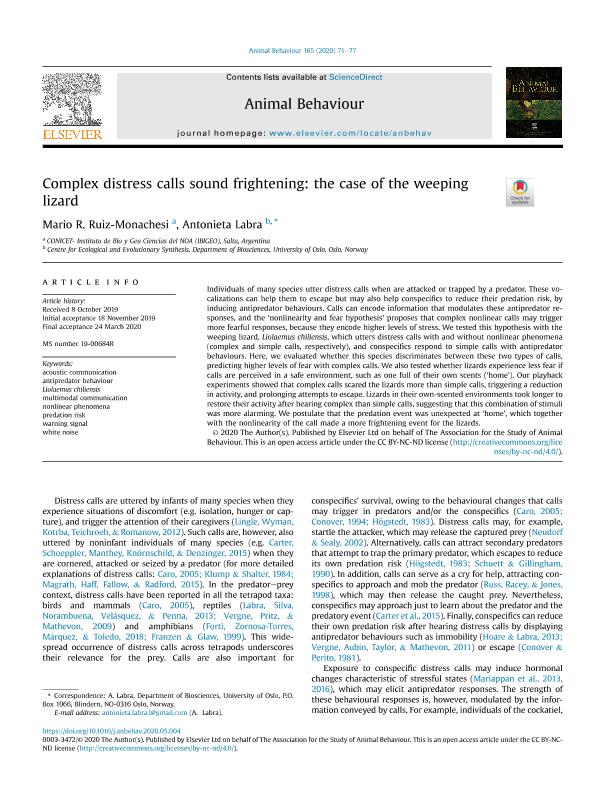Mostrar el registro sencillo del ítem
dc.contributor.author
Ruiz Monachesi, Mario Ricardo

dc.contributor.author
Labra Lillo, Maria Antonieta

dc.date.available
2021-10-21T15:35:23Z
dc.date.issued
2020-07
dc.identifier.citation
Ruiz Monachesi, Mario Ricardo; Labra Lillo, Maria Antonieta; Complex distress calls sound frightening: the case of the weeping lizard; Academic Press Ltd - Elsevier Science Ltd; Animal Behaviour; 165; 7-2020; 71-77
dc.identifier.issn
0003-3472
dc.identifier.uri
http://hdl.handle.net/11336/144634
dc.description.abstract
Individuals of many species utter distress calls when are attacked or trapped by a predator. These vocalizations can help them to escape but may also help conspecifics to reduce their predation risk, by inducing antipredator behaviours. Calls can encode information that modulates these antipredator responses, and the ‘nonlinearity and fear hypothesis’ proposes that complex nonlinear calls may trigger more fearful responses, because they encode higher levels of stress. We tested this hypothesis with the weeping lizard, Liolaemus chiliensis, which utters distress calls with and without nonlinear phenomena (complex and simple calls, respectively), and conspecifics respond to simple calls with antipredator behaviours. Here, we evaluated whether this species discriminates between these two types of calls, predicting higher levels of fear with complex calls. We also tested whether lizards experience less fear if calls are perceived in a safe environment, such as one full of their own scents (‘home’). Our playback experiments showed that complex calls scared the lizards more than simple calls, triggering a reduction in activity, and prolonging attempts to escape. Lizards in their own-scented environments took longer to restore their activity after hearing complex than simple calls, suggesting that this combination of stimuli was more alarming. We postulate that the predation event was unexpected at ‘home’, which together with the nonlinearity of the call made a more frightening event for the lizards.
dc.format
application/pdf
dc.language.iso
eng
dc.publisher
Academic Press Ltd - Elsevier Science Ltd

dc.rights
info:eu-repo/semantics/openAccess
dc.rights.uri
https://creativecommons.org/licenses/by-nc-nd/2.5/ar/
dc.subject
ACOUSTIC COMMUNICATION
dc.subject
ANTIPREDATOR BEHAVIOUR
dc.subject
LIOLAEMUS CHILIENSIS
dc.subject
MULTIMODAL COMMUNICATION
dc.subject
NONLINEAR PHENOMENA
dc.subject
PREDATION RISK
dc.subject
WARNING SIGNAL
dc.subject
WHITE NOISE
dc.subject.classification
Zoología, Ornitología, Entomología, Etología

dc.subject.classification
Ciencias Biológicas

dc.subject.classification
CIENCIAS NATURALES Y EXACTAS

dc.title
Complex distress calls sound frightening: the case of the weeping lizard
dc.type
info:eu-repo/semantics/article
dc.type
info:ar-repo/semantics/artículo
dc.type
info:eu-repo/semantics/publishedVersion
dc.date.updated
2021-09-07T13:54:52Z
dc.journal.volume
165
dc.journal.pagination
71-77
dc.journal.pais
Países Bajos

dc.journal.ciudad
Amsterdam
dc.description.fil
Fil: Ruiz Monachesi, Mario Ricardo. Consejo Nacional de Investigaciones Científicas y Técnicas. Centro Científico Tecnológico Conicet - Salta. Instituto de Bio y Geociencias del NOA. Universidad Nacional de Salta. Facultad de Ciencias Naturales. Museo de Ciencias Naturales. Instituto de Bio y Geociencias del NOA; Argentina
dc.description.fil
Fil: Labra Lillo, Maria Antonieta. University of Oslo. Center for Ecological and Evolutionary Synthesis; Noruega
dc.journal.title
Animal Behaviour

dc.relation.alternativeid
info:eu-repo/semantics/altIdentifier/url/https://www.sciencedirect.com/science/article/pii/S0003347220301317
dc.relation.alternativeid
info:eu-repo/semantics/altIdentifier/doi/https://doi.org/10.1016/j.anbehav.2020.05.004
Archivos asociados
